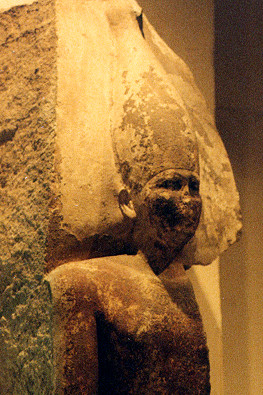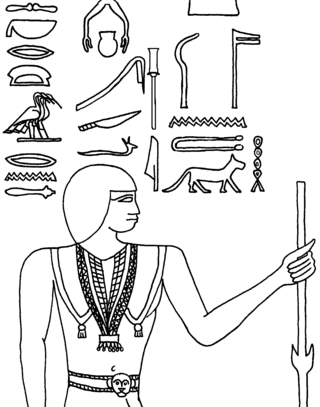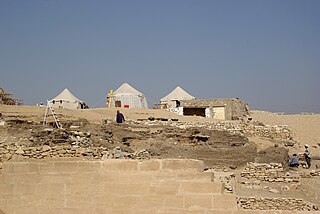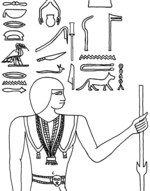
Hesy-Ra was an ancient Egyptian high official during the early Third Dynasty of Egypt. His most notable title was Wer-ibeḥsenjw, meaning either "Great one of the ivory cutters" or "Great one of the dentists", which makes him the earliest named dentist. His tomb is noted for its paintings and cedar wood panels.

Huni was an ancient Egyptian king, the last pharaoh of the Third Dynasty of Egypt during the Old Kingdom period. Following the Turin king list, he is commonly credited with a reign of 24 years, ending c. 2613 BC.

Sehertawy Intef I was a local nomarch at Thebes during the early First Intermediate Period and the first member of the 11th Dynasty to lay claim to a Horus name. Intef reigned from 4 to 16 years c. 2120 BC or c. 2070 BC during which time he probably waged war with his northern neighbor, the Coptite nomarch Tjauti. Intef was buried in a saff tomb at El-Tarif, known today as Saff el-Dawaba.

Khentkaus II was a royal woman who lived in Ancient Egypt. She was a wife of Egyptian king Neferirkare Kakai of the Fifth Dynasty. She was the mother of two kings, Neferefre and Nyuserre Ini.

Nebka is the throne name of an ancient Egyptian pharaoh of the Third Dynasty during the Old Kingdom period, in the 27th century BCE. He is thought to be identical with the Hellenized name Νεχέρωχις recorded by the Egyptian priest Manetho of the much later Ptolemaic period.

Nimaathap was an ancient Egyptian queen consort at the transition time from 2nd Dynasty to 3rd Dynasty. Nimaathap may have acted as regent for her son Djoser.

Sneferu, well known under his Hellenized name Soris, was the founding pharaoh of the Fourth Dynasty of Egypt during the Old Kingdom. Estimates of his reign vary, with for instance The Oxford History of Ancient Egypt suggesting a reign from around 2613 to 2589 BC, a reign of 24 years, while Rolf Krauss suggests a 30-year reign, and Rainer Stadelmann a 48-year reign. He built at least three pyramids that survive to this day and introduced major innovations in the design and construction of pyramids.

Kawab is the name of an ancient Egyptian prince of the 4th Dynasty. He was the eldest son of King Khufu and Queen Meritites I. Kawab served as vizier and was buried in the double mastaba G 7110–7120 in the east field which is part of the Giza Necropolis.
Khufukhaf I was an ancient Egyptian prince and vizier of the 4th Dynasty.
Meresankh I was an ancient Egyptian kingʻs wife and the mother of King Sneferu. She may have been a wife of King Huni, the last king of the 3rd Dynasty.
Netjeraperef is the name of an ancient Egyptian high official and prince. He lived and worked at the transition time between 3rd and 4th Dynasty during the Old Kingdom period.
Nefermaat II was a member of the Egyptian royal family during the 4th Dynasty and vizier of Khafre.
Sabef (s3b.f) was an ancient Egyptian official under king Qa'a in the First Dynasty, around 2900 BC.

Inykhnum was an ancient Egyptian high-ranking official who worked and lived during the transition time between Second and Third Dynasty of Egypt. The king(s) under which he served are not known for certain, the subject being currently highly disputed.
Pehernefer is the personal name of an ancient Egyptian high official, who held office under the reigns of the pharaohs Huni and Sneferu, in the time between the end of 3rd Dynasty and the beginning of the 4th Dynasty during the Old Kingdom period.

Khabawsokar was an Ancient Egyptian high official during the early to midst 3rd dynasty. He is famous for his tomb inscription and his unique nickname.
Akhetaa was an ancient Egyptian high official during the mid to late 3rd Dynasty. He is mostly known for his tomb inscriptions, which refer to various seldom used titles as well as to the shadowy king Nebka, in whose cult Akhetaa served.

The Mastaba of Hesy-re is an ancient Egyptian tomb complex in the great necropolis of Saqqara in Egypt. It is the final resting place of the high official Hesy-re, who served in office during the Third Dynasty under King Djoser (Netjerikhet). His large mastaba is renowned for its well-preserved wall paintings and relief panels made from imported Lebanese cedar, which are today considered masterpieces of Old Kingdom wood carving. The mastaba itself is the earliest example of a painted tomb from the Old Kingdom and the only known example from the Third Dynasty. The tomb was excavated by the Egyptologists Auguste Mariette and James Edward Quibell.
Kaemtjenent was an ancient Egyptian official under pharaoh Djedkare Isesi in the late Fifth Dynasty, during the Old Kingdom period.
Idu was an official during the Sixth Dynasty, buried in Giza East Field, tomb G7102. He probably lived and served during the reign of Pepi I Meryre. He is the father of Qar whose tomb is nearby and Bendjet, buried in G7215.












